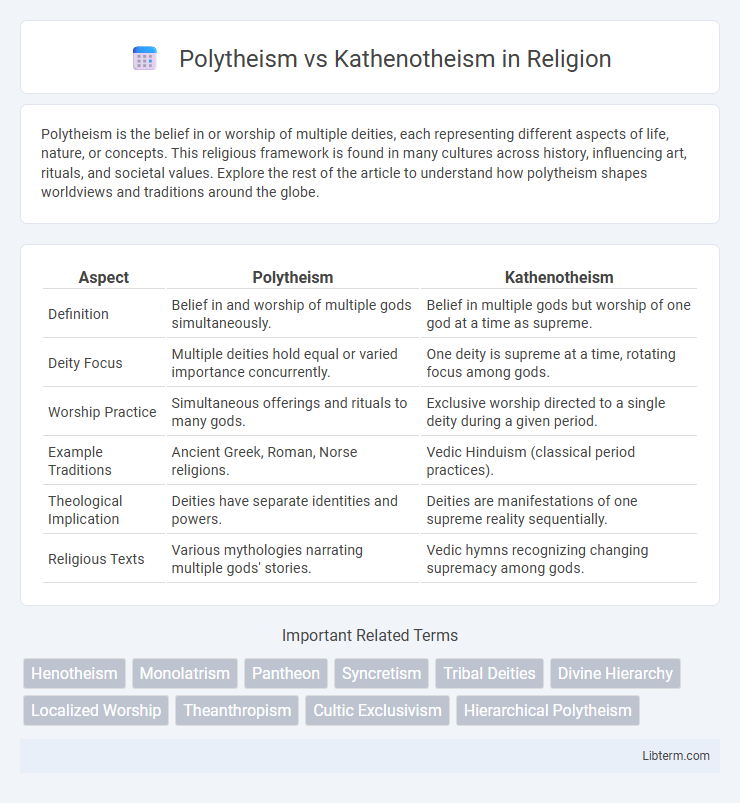Polytheism is the belief in or worship of multiple deities, each representing different aspects of life, nature, or concepts. This religious framework is found in many cultures across history, influencing art, rituals, and societal values. Explore the rest of the article to understand how polytheism shapes worldviews and traditions around the globe.
Table of Comparison
| Aspect | Polytheism | Kathenotheism |
|---|---|---|
| Definition | Belief in and worship of multiple gods simultaneously. | Belief in multiple gods but worship of one god at a time as supreme. |
| Deity Focus | Multiple deities hold equal or varied importance concurrently. | One deity is supreme at a time, rotating focus among gods. |
| Worship Practice | Simultaneous offerings and rituals to many gods. | Exclusive worship directed to a single deity during a given period. |
| Example Traditions | Ancient Greek, Roman, Norse religions. | Vedic Hinduism (classical period practices). |
| Theological Implication | Deities have separate identities and powers. | Deities are manifestations of one supreme reality sequentially. |
| Religious Texts | Various mythologies narrating multiple gods' stories. | Vedic hymns recognizing changing supremacy among gods. |
Understanding Polytheism: Core Concepts
Polytheism involves the belief in and worship of multiple gods, each with distinct attributes, powers, and domains, reflecting a diverse pantheon. It emphasizes the coexistence of various deities, often linked to natural phenomena, human experiences, and cultural values. This contrasts with kathenotheism, where worship is directed toward one god at a time while acknowledging the existence of others.
Defining Kathenotheism: Origins and Meaning
Kathenotheism, originating from the Greek words "kath' henoton," meaning "one at a time," refers to the worship of one god at a time while accepting the existence of multiple deities. This belief system is distinct from polytheism, which involves the simultaneous veneration of many gods. Kathenotheism is often found in ancient religions and some strands of Hinduism, where gods are worshipped sequentially based on context or need.
Historical Contexts: Polytheism Across Cultures
Polytheism, the belief in multiple gods, has been a foundational aspect of many ancient civilizations, including the Greeks, Romans, Egyptians, and Mesopotamians, each attributing specific domains and characteristics to their deities. Kathenotheism, a nuanced form of polytheism found in Vedic traditions, involves worshiping one god at a time while acknowledging the existence of others, reflecting a dynamic and personalized approach to divinity. Historically, polytheism's cultural expressions reveal diverse ritual practices, mythologies, and theological developments that shaped societal values and governance across regions.
The Emergence of Kathenotheistic Beliefs
The emergence of kathenotheistic beliefs marks a nuanced development within polytheistic traditions, emphasizing the worship of one deity at a time while acknowledging the existence of multiple gods. This theological approach contrasts with classic polytheism, which involves simultaneous veneration of many deities without exclusive focus. Kathenotheism is notably present in some ancient Hindu practices and early Vedic religion, where each god receives singular devotion during specific rituals, highlighting a dynamic and fluid divine hierarchy.
Key Similarities Between Polytheism and Kathenotheism
Polytheism and Kathenotheism both involve the worship of multiple deities, recognizing a pantheon rather than a single god. Both practices often attribute distinct powers and responsibilities to each deity, reflecting diverse aspects of life and nature. Rituals and prayers in both systems can concentrate on one god at a time while acknowledging the existence and influence of others.
Fundamental Differences: Worship Practices and Theology
Polytheism involves the simultaneous worship of multiple gods, each with distinct personalities, domains, and mythologies, reflecting a pantheon where deities coexist independently. Kathenotheism centers on the worship of one god at a time while acknowledging the existence of other deities, emphasizing a sequential or situational devotion rather than concurrent reverence. Theologically, polytheism perceives gods as separate entities with specialized powers, whereas kathenotheism adopts a fluid approach to divine focus, often integrating diverse deities into varying aspects of singular worship experiences.
Notable Examples of Polytheism and Kathenotheism in History
Ancient Greek polytheism prominently featured deities like Zeus, Hera, and Athena, each worshipped simultaneously within a diverse pantheon. In contrast, Hindu kathenotheism exemplifies worship where gods such as Indra or Agni are revered one at a time as supreme, highlighting a sequential elevation rather than concurrent worship. Mesopotamian religion also showcases polytheism, with gods like Anu and Enlil, whereas Vedic traditions illustrate kathenotheism through hymns dedicating supremacy alternately to different deities.
Philosophical Implications of Multiple Deities
Polytheism, characterized by the belief in multiple gods with distinct personalities and domains, emphasizes a pluralistic worldview reflecting diverse cosmic forces and human experiences, fostering a philosophical framework that values multiplicity and complexity in divine nature. Kathenotheism, the worship of one god at a time while acknowledging others, presents a dynamic theological approach that explores relational and situational divinity, challenging static conceptions of the divine and suggesting a fluid, context-dependent spirituality. These differing models influence metaphysical understandings of divinity, ethics derived from divine plurality, and the human capacity to relate to the sacred, shaping religious consciousness and philosophical discourse on the nature of ultimate reality.
Influence on Modern Spirituality and Religions
Polytheism, characterized by belief in multiple gods with distinct identities, has profoundly influenced modern spirituality through its incorporation of diverse deities and pantheons in contemporary paganism and neopagan practices. Kathenotheism, the worship of one god at a time while acknowledging the existence of others, shapes certain modern religious philosophies, including aspects of Hinduism and some New Age beliefs, by promoting a flexible, individualized approach to divinity. Both frameworks contribute to modern spiritual diversity by encouraging pluralistic and inclusive interpretations of the divine, enriching religious expression and interfaith dialogue.
Polytheism vs Kathenotheism: Contemporary Relevance
Polytheism embraces the worship of multiple deities simultaneously, reflecting diverse cultural narratives and spiritual practices worldwide. Kathenotheism involves devotion to one god at a time while acknowledging the existence of others, offering a flexible framework for individual religious experience. In contemporary relevance, this distinction influences interfaith dialogue and personal spirituality, highlighting different approaches to divine multiplicity and religious identity.
Polytheism Infographic

 libterm.com
libterm.com